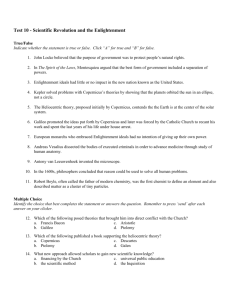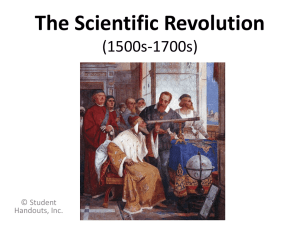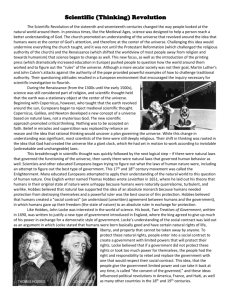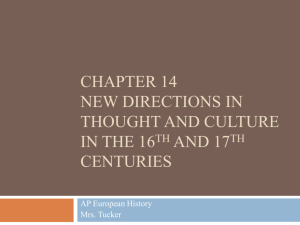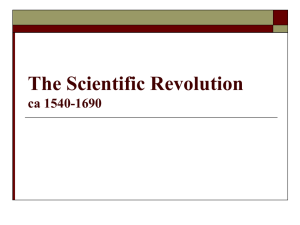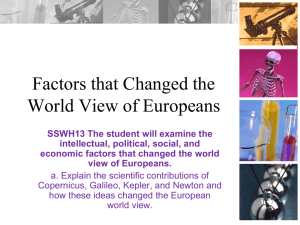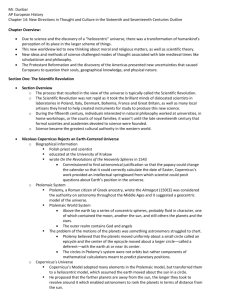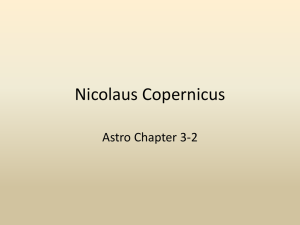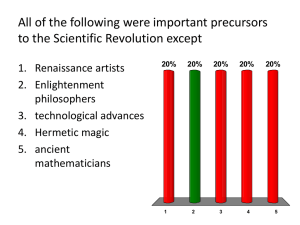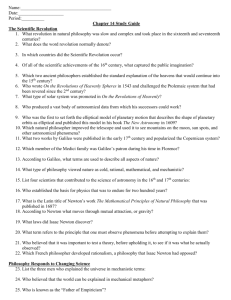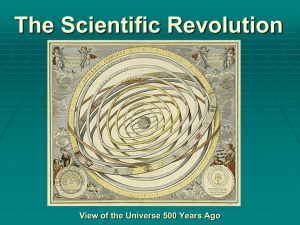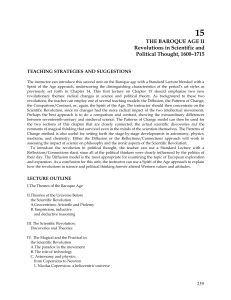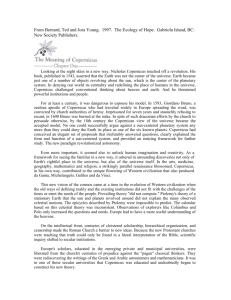Notes & Outline
advertisement
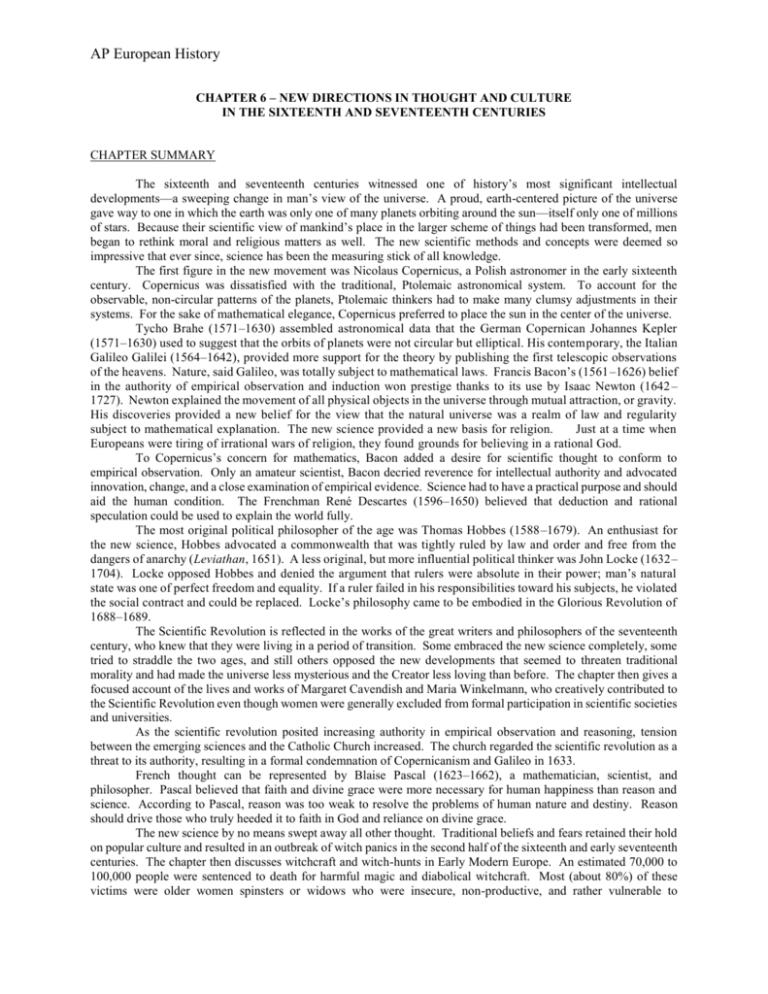
AP European History CHAPTER 6 – NEW DIRECTIONS IN THOUGHT AND CULTURE IN THE SIXTEENTH AND SEVENTEENTH CENTURIES CHAPTER SUMMARY The sixteenth and seventeenth centuries witnessed one of history’s most significant intellectual developments—a sweeping change in man’s view of the universe. A proud, earth-centered picture of the universe gave way to one in which the earth was only one of many planets orbiting around the sun—itself only one of millions of stars. Because their scientific view of mankind’s place in the larger scheme of things had been transformed, men began to rethink moral and religious matters as well. The new scientific methods and concepts were deemed so impressive that ever since, science has been the measuring stick of all knowledge. The first figure in the new movement was Nicolaus Copernicus, a Polish astronomer in the early sixteenth century. Copernicus was dissatisfied with the traditional, Ptolemaic astronomical system. To account for the observable, non-circular patterns of the planets, Ptolemaic thinkers had to make many clumsy adjustments in their systems. For the sake of mathematical elegance, Copernicus preferred to place the sun in the center of the universe. Tycho Brahe (1571–1630) assembled astronomical data that the German Copernican Johannes Kepler (1571–1630) used to suggest that the orbits of planets were not circular but elliptical. His contemporary, the Italian Galileo Galilei (1564–1642), provided more support for the theory by publishing the first telescopic observations of the heavens. Nature, said Galileo, was totally subject to mathematical laws. Francis Bacon’s (1561 –1626) belief in the authority of empirical observation and induction won prestige thanks to its use by Isaac Newton (1642 – 1727). Newton explained the movement of all physical objects in the universe through mutual attraction, or gravity. His discoveries provided a new belief for the view that the natural universe was a realm of law and regularity subject to mathematical explanation. The new science provided a new basis for religion. Just at a time when Europeans were tiring of irrational wars of religion, they found grounds for believing in a rational God. To Copernicus’s concern for mathematics, Bacon added a desire for scientific thought to conform to empirical observation. Only an amateur scientist, Bacon decried reverence for intellectual authority and advocated innovation, change, and a close examination of empirical evidence. Science had to have a practical purpose and should aid the human condition. The Frenchman René Descartes (1596–1650) believed that deduction and rational speculation could be used to explain the world fully. The most original political philosopher of the age was Thomas Hobbes (1588–1679). An enthusiast for the new science, Hobbes advocated a commonwealth that was tightly ruled by law and order and free from the dangers of anarchy (Leviathan, 1651). A less original, but more influential political thinker was John Locke (1632– 1704). Locke opposed Hobbes and denied the argument that rulers were absolute in their power; man’s natural state was one of perfect freedom and equality. If a ruler failed in his responsibilities toward his subjects, he violated the social contract and could be replaced. Locke’s philosophy came to be embodied in the Glorious Revolution of 1688–1689. The Scientific Revolution is reflected in the works of the great writers and philosophers of the seventeenth century, who knew that they were living in a period of transition. Some embraced the new science completely, some tried to straddle the two ages, and still others opposed the new developments that seemed to threaten traditional morality and had made the universe less mysterious and the Creator less loving than before. The chapter then gives a focused account of the lives and works of Margaret Cavendish and Maria Winkelmann, who creatively contributed to the Scientific Revolution even though women were generally excluded from formal participation in scientific societies and universities. As the scientific revolution posited increasing authority in empirical observation and reasoning, tension between the emerging sciences and the Catholic Church increased. The church regarded the scientific revolution as a threat to its authority, resulting in a formal condemnation of Copernicanism and Galileo in 1633. French thought can be represented by Blaise Pascal (1623–1662), a mathematician, scientist, and philosopher. Pascal believed that faith and divine grace were more necessary for human happiness than reason and science. According to Pascal, reason was too weak to resolve the problems of human nature and destiny. Reason should drive those who truly heeded it to faith in God and reliance on divine grace. The new science by no means swept away all other thought. Traditional beliefs and fears retained their hold on popular culture and resulted in an outbreak of witch panics in the second half of the sixteenth and early seventeenth centuries. The chapter then discusses witchcraft and witch-hunts in Early Modern Europe. An estimated 70,000 to 100,000 people were sentenced to death for harmful magic and diabolical witchcraft. Most (about 80%) of these victims were older women spinsters or widows who were insecure, non-productive, and rather vulnerable to AP European History accusation. This may have been because of a general fear by men that women were beginning to break away from their control or that women, as midwives, were responsible for the death of children and spouses during birth. The witch-hunts were the result of a general belief in the powers of magic, a belief that died with the rise of a more scientific worldview in the seventeenth century. The chapter concludes with an overview of Baroque art, noting the work of Caravaggio, Rubens, and Bernini. Baroque art came to be associated closely with both Roman Catholicism and absolutist politics. One of the greatest monuments to Baroque art, and political absolutism, is Louis XIV’s palace at Versailles. OUTLINE I. The Scientific Revolution A. Nicolaus Copernicus Rejects an Earth-Centered Universe Read the Document “Nicolaus Copernicus: On the Revolution of the Heavenly Spheres (1500s)”on MyHistoryLab.com View the Image “Illustrations for The Emperor’s Astronomy” on MyHistoryLab.com View the Closer Look “The Copernican Universe” on MyHistoryLab.com B. Tycho Brahe and Johannes Kepler Make New Scientific Observations C. Galileo Galilei Argues for a Universe of Mathematical Laws Read the Document “Galileo, ‘Third Letter on Sunspots’ (Italian States), 1612” on MyHistoryLab.com D. Isaac Newton Discovers the Laws of Gravitation Read the Document “Isaac Newton, from Opticks” on MyHistoryLab.com II. Philosophy Responds to Changing Science A. Nature as Mechanism B. Francis Bacon: The Empirical Method Read the Document “The Novum Organum (1620)” on MyHistoryLab.com C. Rene Descartes: The Method of Rational Deduction Read the Document “Rene Descartes, The Discourse on Method” on MyHistoryLab.com D. Thomas Hobbes: Apologist for Absolute Government Read the Document “Thomas Hobbes, The Leviathan” on MyHistoryLab.com E. John Locke: Defender of Moderate Liberty and Toleration Read the Document “John Locke, Essay Concerning Human Understanding” on MyHistoryLab.com III. The New Institutions of Expanding Natural Knowledge IV. Women in the World of the Scientific Revolution V. The New Science and Religious Faith A. The Case of Galileo Read the Document “Galileo Galilei, Letter to the Grand Duchess Christina (1630s)” on MyHistoryLab.com B. Blaise Pascal: Reason and Faith AP European History C. The English Approach to Science and Religion VI. Continuing Superstition A. Witch-Hunts and Panic Watch the Video “Video Lectures: Witch Hunts” on MyHistoryLab.com B. Village Origins C. Influence of the Clergy D. Who were the Witches? View the Closer Look “Women and Witchcraft” on MyHistoryLab.com E. End of the Witch-Hunts VII. Baroque Art View the Closer Look “Rembrandt, The Anatomy Lesson of Dr. Tulp” on MyHistoryLab.com View the Architectural Panorama “Blenheim Palace” on MyHistoryLab.com VIII. In Perspective
